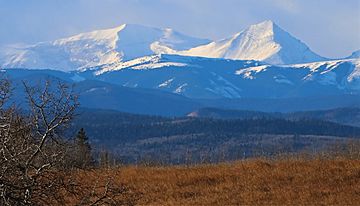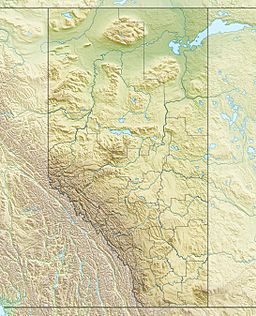Mount Cornwall facts for kids
Quick facts for kids Mount Cornwall |
|
|---|---|

Mount Cornwall is the gentle peak left of center. Mount Glasgow to right.
|
|
| Highest point | |
| Elevation | 2,970 m (9,740 ft) |
| Prominence | 730 m (2,400 ft) |
| Parent peak | Tombstone Mountain (3002 m) |
| Listing | Mountains of Alberta |
| Geography | |
| Location | Alberta, Canada |
| Parent range | Canadian Rockies |
| Topo map | NTS 82J/10 |
| Geology | |
| Age of rock | Cambrian |
| Type of rock | limestone |
| Climbing | |
| First ascent | 1949, Arnold Choquette |
| Easiest route | Scramble |
Mount Cornwall is a tall mountain in the Canadian Rockies of Alberta, Canada. It stands about 2,970 meters (9,744 feet) high. You can find it in a beautiful area called Kananaskis Country, between the Elbow River valley and the Little Elbow River valley. On a clear day, you can even see this mountain from Highway 66! The closest taller mountain to Mount Cornwall is Tombstone Mountain, which is about 6.6 kilometers (4.1 miles) away to the southwest.
History of Mount Cornwall
Mount Cornwall got its name in 1922. It was named after a British warship called HMS Cornwall. This ship was part of an important sea battle during the First World War. That battle happened far away in the South Atlantic.
The very first time someone successfully climbed to the top of Mount Cornwall was in 1949. A climber named Arnold Choquette made this exciting first ascent.
The mountain's name became official in 1951. This was decided by the Geographical Names Board of Canada.
How Mount Cornwall Was Formed
Mount Cornwall is made of sedimentary rock. This type of rock forms from layers of sand, mud, and tiny bits of sea creatures that settle over millions of years. These layers were laid down during ancient times, from the Precambrian to the Jurassic periods.
Long ago, these rocks formed in shallow seas. Later, a huge event called the Laramide orogeny happened. This was when big forces pushed the land, causing these sedimentary rocks to fold and lift up. They were pushed east and even moved over younger rocks, creating the mountains we see today.
Weather and Climate Around Mount Cornwall
Mount Cornwall is located in a subarctic climate zone. This means it has very cold winters with lots of snow. The summers are usually mild.
Temperatures can drop really low, sometimes below -20 degrees Celsius (-4 degrees Fahrenheit). With the wind chill, it can feel even colder, below -30 degrees Celsius (-22 degrees Fahrenheit).
The snow and rain that fall on the mountain eventually melt and flow into the Elbow River. This river then joins the Bow River, which is a larger river in the area.



